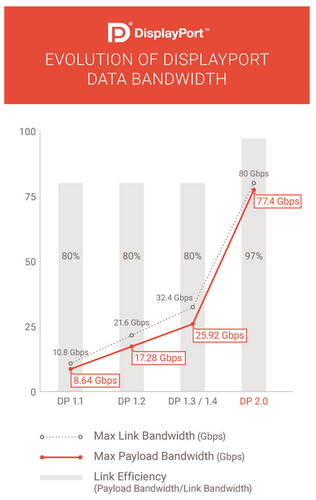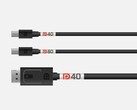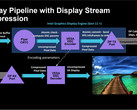Even though 4K and HDR are just now starting to be the norm as far as entertainment displays go, the race for resolutions above 8K is pushing the adoption for advanced display standards ahead of time. HDMI already made the jump to version 2.1, but this standard is mostly targeted at TVs. PC gamers usually opt for high refresh rate monitors compatible with the DisplayPort standard, which will soon be updated to version 2.0, in preparation for the arrival of 6K and 8K and even 10K+ monitor setups.
Right out of the gate, version 2.0 brings almost triple the bandwidth of the current DisplayPort 1.4 iteration, with a maximum raw peak speed of 80 Gbps through 4 lanes (HMDI 2.1 caps at 48 Gbps). The new standard also introduces a more effective coding scheme to effectively reduce coding overhead. As a result, DisplayPort 2.0 enables support for uncompressed 8K resolutions @30-bit color depths (HDR support) running at 60 Hz. Additionally, 10K resolutions are now possible for 24-bit color depths and 60 Hz refresh rates, and compressed (DSC) 16K resolutions are also supported. Gamers looking for high refresh rates will be happy to know that DisplayPort 2.0 also support 4K resolutions in HDR mode at 144 Hz.
DisplayPort 2.0 will also introduce new cables that are derived from the USB-C Thunderbolt 3 standard. These may be more expensive than current Thunderbolt 3 cables, but there should be an improved passive cable option that delivers only 40 Gbps over conventional copper connections in order to reduce costs.
Other features include mandatory (not enforced) DSC (display stream compression) support that can achieve 3:1 compression rates without introducing visual artifacts or any latency, Panel Replay for increased energy efficiency primarily intended for laptops and mobile devices, plus simplified coding for branch devices.
The first DisplayPort 2.0 devices are expected to hit the market in the second half of 2020.
Loading Comments
I first stepped into the wondrous IT&C world when I was around seven years old. I was instantly fascinated by computerized graphics, whether they were from games or 3D applications like 3D Max. I'm also an avid reader of science fiction, an astrophysics aficionado, and a crypto geek. I started writing PC-related articles for Softpedia and a few blogs back in 2006. I joined the Notebookcheck team in the summer of 2017 and am currently a senior tech writer mostly covering processor, GPU, and laptop news.
> Expert Reviews and News on Laptops, Smartphones and Tech Innovations > News > News Archive > Newsarchive 2019 06 > DisplayPort 2.0 standard announced
Bogdan Solca, 2019-06-27 (Update: 2019-06-27)





















